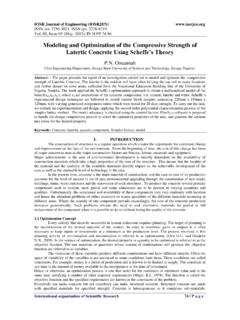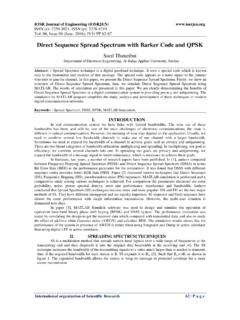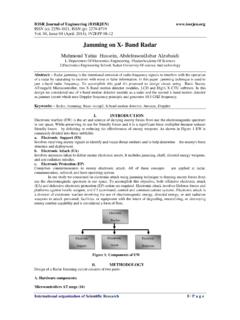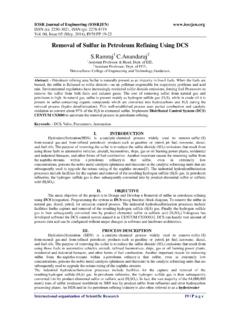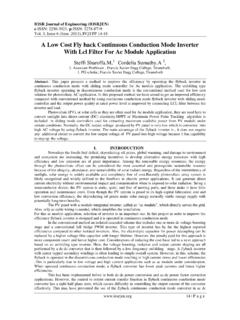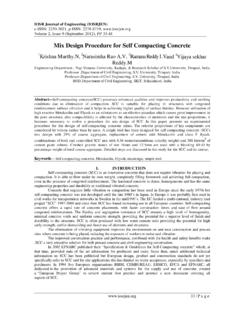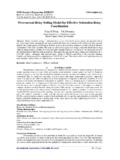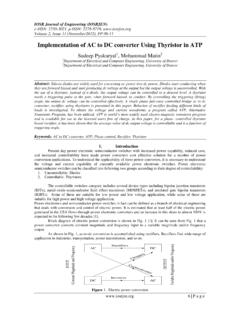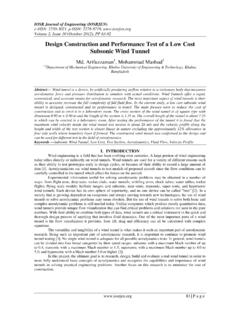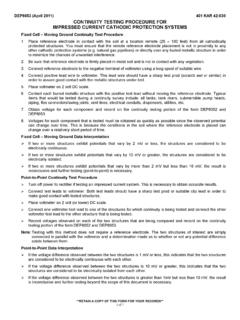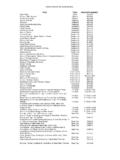Transcription of Ship hull corrosion caused by default and lack of ...
1 IOSR Journal of Engineering (IOSRJEN) ISSN (e): 2250-3021, ISSN (p): 2278-8719 Vol. 04, Issue 02 (February. 2014), ||V2|| PP 34-39 International organization of Scientific Research 34 | P a g e Ship hull corrosion caused by default and lack of maintenance on the impressed current cathodic protection Fernando B. Mainier1, Vitor Perassolli2 1 Escola de Engenharia, Universidade Federal Fluminense, Niter i, RJ, Brazil, 2 Posgradua o em Engenharia Civil, Escola de Engenharia, Universidade Federal Fluminense, Niter i, RJ, Brazil, Abstract: - This article presents a case study of corrosion of a ship hull that began after continuous failure of the impressed current cathodic protection system. The purpose of this article is not to question or criticise the design, installation, maintenance, or operation of the cathodic protection system, but only to show through the inspection carried out that the main aspects of the corrosive process that occurred when it was anchored for more than six months.
2 In order to leave the ship in normal operating conditions, repairs were conducted that consisted of cleaning with pressurised water blasting, welding repair of corroded plates, paint application, and installation of zinc anodes in cathodic protection replacement. Keywords: - Cathodic protection, corrosion , failure, ship hull , zinc anode I. INTRODUCTION The study of corrosion and anti- corrosion protection technique development began in the 19th century and continues to this day. However, corrosion and corrosion protection are known to be associated with a range of disciplines extending from chemistry to human behaviour. corrosion is defined as the deterioration of material by chemical or electrochemical actions of a corrosive medium. Due to this, corrosion is a permanent challenge to man, because when more science creates and develops and the technology applies and advances, the more she finds spaces and ways of doing this.
3 Generally speaking, we can say that a corrosive attack carries considerable costs, which may, in certain cases, include environmental pollution, compromise the operational safety of the equipment, and promote catastrophic accidents and the loss of human life. Problems associated with corrosion due to seawater have been studied for many years, but despite the published information about the behaviour of materials in seawater, failures still occur. The corrosion rates of carbon steel range from to mm/year depending on several factors, such as oxygen, pH, contaminants, macro-, and micro-organisms. Some of these factors are interrelated and depend on physical, chemical, and biological variables, such as depth, temperature, nearby rivers, contamination by industrial effluents, and the availability of nutrients [1, 2]. The interaction between biological activity and steel performance is very important in seawater.
4 Depending on the contact time, the macro fouling, such as barnacles and mussels, can be either protective or result in accelerated corrosion depending on the area of steel exposed and the extent of the amount of biological fouling. The corrosion of carbon steel in seawater can occur under various forms: localised, generalised, plates, pitting, and considering the properties of seawater are common, the occurrence of corrosion by differential aeration, crevice corrosion , and corrosion under deposits. Anticorrosive protection of ships and maritime facilities is generally accomplished through cathodic protection by application of coatings that resist the aggressive action of seawater. Currently, the cathodic protection of ships is made of cathodic protection with galvanic anodes (aluminium or zinc) or impressed current cathodic protection. Cathodic protection of small boats is simple, but medium and large ships are more complex and require very specific plans.
5 The principles of this technology come from the past. It is believed that the first ship to use the cathodic protection was during the Sammarang Sea voyage to Nova Scotia in 1824 1825 [3]. Systems using galvanic (sacrificial anodes) for current cathodic protection are provided by the potential difference that exists between the galvanic anode (aluminium, magnesium, or zinc) and the carbon steel structure. In cathodic protection of a metallic structure, the flow of the electric current is provided by the potential difference between the metal surface to be protected and the anode, which has a more negative potential, according to the following electrochemical reactions: Anodic: Zn 2 e- Zn2+ Cathodic: H2O + O2 + 2 e- 2 OH- (aerated seawater) Figure 1 represents the system of protection by galvanic anodes (zinc) for ship hull (carbon steel) protection. Ship hull corrosion caused by default and lack of maintenance on the impressed current cathodic International organization of Scientific Research 35 | P a g e Figure 1 Carbon steel protection by zinc anode in aerated seawater In the case of cathodic protection of the stern (back zone, where the propeller, which is usually made from bronze, is located) with zinc anodes requires a higher number of anodes than the bow to prevent galvanic corrosion , as shown in Figure 2.
6 Figure 2 Aspects of galvanic anodes disposal in the stern and the bow In impressed current cathodic protection, buried metal structures receive the protection current from an external source or current rectifier installed on the surface, and using a set disperser current in the electrolyte, which consists of an inert anode. The inert or nearly inert anodes can be made of graphite, iron-silicon alloys, platinum clad titanium, or 2% silver-lead. The source of the electrical current from by the rectifier converts AC power into a DC current and injects this into the medium by means of inert anodes, whose selection depends on several factors, such as cost, useful life, conductivity, and resistivity of the corrosive medium [3,4,5]. Figure 3 shows the system of protection using inert anodes for the protection of the ship hull (carbon steel). Currently, the use of impressed current cathodic protection are favoured for protecting the hulls of medium and large ships based on three important factors: the development of direct current rectifiers that are more compact and efficient, continuous monitoring of the potential for corrosion protection, and automation of current injection based on the critical condition of seawater.
7 It is important to manage the corrosive process because, when the ship is at sea, aggression increases as a function of salinity and the speed of the ship, while when anchored, the hull is exposed to fresh water or effluents, which may modify the conductivity of the medium [6,7]. Ship hull corrosion caused by default and lack of maintenance on the impressed current cathodic International organization of Scientific Research 36 | P a g e Figure 3 Carbon steel protected by impressed current cathodic in aerated seawater Figure 4 shows the system of protection by inert anodes for the ship hull (carbon steel) protection using a control unit based on a reference electrode. Figure 4 Ship protection scheme with impressed current cathodic The most commonly used anodes for ship protection projects are platinised titanium and lead-antimony-silver alloys.
8 The reference electrodes (RE) are, normally, made of zinc and are meant to determine the potential of the hull . When connected, the control unit automatically provides information for the rectifier to inject by inert anodes the amount of current required to anti- corrosion protection of the hull ship [6,7]. III. INSPECTIONS OF A SHIP DRY DOCKED FOR REPAIRS The ship that was inspected and presented in this article was 96 m long, 12 m wide, 4 m draught, and an almost m maximum draught, and its value was estimated at approximately $55 million. The ship had an impressed current cathodic protection system. According to the information obtained from inspectors the corrosion of the hull began to occur continuously after the anti- corrosion protection system failed. Same with the corrosion protection system not functioning properly, the ship continued to operate normally because the paint system still provided tenuous anti- corrosion protection.
9 When the corrosion process became very evident and could compromise the integrity of the vessel, the ship was dry docked for inspection and repairs. The photographic sequence (Figure 5) of the surface of the ship's hull , show an intense corrosion caused by seawater. corrosion products shows various colorations, localised corrosion in the form of pitting, cavities (shallow, wide, or elliptical) and holes , barnacle depositions, residue of the antifouling paint (the inhibition of living organism growth on the surface), loose flakes of plates, and crevices. The pitting (narrow and deep) is more dangerous than uniform corrosion damage because it is more difficult to detect, predict, and design against. Considerable parts of the pitting are covered by corrosion products and shellfish adherents. Ship hull corrosion caused by default and lack of maintenance on the impressed current cathodic International organization of Scientific Research 37 | P a g e Some deep pitting resulted in perforation of the carbon steel plates.
10 The products of carbon steel plate corrosion are primarily Fe2O3, , Fe3O4, and FeO. The white deposits result from the adhesion of shellfish, barnacles, and other sea animals present in seawater. Also on the surface of the hull were remains or vestiges of antifouling red paint. Figure 5 Photographic sequence of the surface of the ship's hull The inspection carried out in the ship's hull showed deterioration of the insulated support (Figure 6) where they installed the inert anodes of the impressed current cathodic protection system. Without the inert anodes, the system could not inject the necessary current hull protection. Figure 6 Insulated support of inert anodes Ship hull corrosion caused by default and lack of maintenance on the impressed current cathodic International organization of Scientific Research 38 | P a g e IV. BLASTING, REPAIR OF hull PLATES AND INSTALLATIONS OF ZINC GALVANIC ANODES The inspection of the ship revealed that 80% of the hull was compromised by corrosion on several levels, from the surface corrosion until the perforation of the carbon steel plate.
